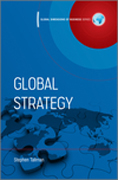
This comprehensive volume from "Blackwell's Global Dimensions of Business" series explores the topic of international strategic management at an MBA or Executive Education level. Authored by an accomplished teacher who possesses a strong understanding of the market, this text offers clear frameworks coupled with lively, international case studies. This book is written by an experienced teacher possessing a strong research profile and a clear understanding of the market. It emphasizes organizational competences and provides a direct bridge to the strategy frameworks and concepts essential to MBA and Executive Education programs. It focuses on capabilities, capability-building and knowledge, and highlights the distinction between input and leveraging in terms of capabilities. It reviews additional opportunities for making performance gains in the international environment and the additional complexity involved in managing in a global - rather than domestic - environment. All chapters include sectionson essential reading, student questions, summaries, case examples, and 'key terms.' INDICE: OUTLINE: NB all chapters have essential reading; student questions; summaries; case examples; and 'key terms' sections.1. Introduction - International Business Strategy in the "Global Era".2. The Objectives of International Strategies.A. Capability Leverage through New Markets.B. Capability Buildingthrough New Inputs.C. Improved Competitive Posture through Risk Reduction, Cost Reduction, and Strategic Maneuvering.3. The Environment of International Strategy.A. Comparative and Competitive Advantage.B. International Financial Markets.C. International Political Relationships.D. Strategy in a Multicultural Milieu.E. Technology Development and Exchange in the Internet Era.4. Industry and Competitive Analysis on a Global Scale.A. Industry Analysis in the Global Marketplace.B. Internationalization and Globalization.C. Configuration and Coordination.D. Life Cycles, Local Markets, and Outsourcing.E. Emerging Markets.F.Manufacturing v. Services.G. E-commerce.5. Capability Processes and the Multinational Enterprise.A. Home Country Advantage.B. Building Capabilities in the International Marketplace.C. Combinatory/ Integration Skills and Competitive Advantage through Knowledge.D. Technical vs. Organizational Capabilities.6. Options in International Strategy.A. Global Integration v. National Responsiveness.B. The Transnational.C. M & A in International Expansion.D. Strategic Alliances and Cooperative Strategies.E. The Strategic Roles of Subsidiaries.F. Financial Strategies.7. Structuring the Multinational Organization.A. Strategies and Structures - the Transnational Model.B. Networks and Matrices - Having it Many Ways.C. Using Alliances.D. The Role of the Center and the De-integration ofHQ Activities.E. Trade, Licensing, and Investment - Complementary Substitutes.8. Managing the Multinational Organization.A. The Structure and Roles of the Top Management Team.B. Control and Coordination Mechanisms.C. Strategic HRM Practices.D. Production, Logistics, and Transfer Pricing Strategies.E. KnowledgeTransfer in the Post-Industrial MNE.F. The Role of Corporate Culture and Normative Controls.9. Subsidiary Strategies.A. Entry Options.Entry Strategies and Global Strategies.Entry Strategies and Corporate Capabilities. Entry Strategies and Corporate Identity. Entry Strategies and Host Country Conditions.Bargaining Power, Ownership, and Control.B. Managing the Subsidiary.Corporate Roles and Local Roles.Expatriates and Locals.Foreign Exchange Risk.Taxes and TransferPrices
- ISBN: 978-1-4051-3610-5
- Editorial: Wiley-Blackwell
- Encuadernacion: Cartoné
- Páginas: 240
- Fecha Publicación: 20/11/2008
- Nº Volúmenes: 1
- Idioma: Inglés
